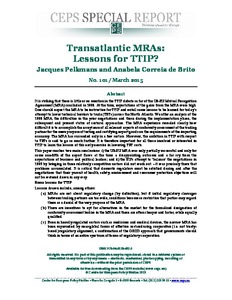Transatlantic MRAs: lessons for TTIP?
"It is striking that there is little or no mention in the TTIP debate so far of the US-EU Mutual Recognition Agreement (MRA) concluded in 1998. At the time, expectations of the gains from the MRA were high. One should expect the MRA to be instructive for TTIP and entail some lessons to be learn...
| Main Author: | |
|---|---|
| Institution: | ETUI-European Trade Union Institute |
| Format: | TEXT |
| Language: | English |
| Published: |
Brussels
2015
CEPS |
| Subjects: | |
| Online Access: | https://www.labourline.org/KENTIKA-19114067124919322499-Transatlantic-MRas-lessons-for.htm |
| _version_ | 1771659901526867968 |
|---|---|
| author | Pelkmans, Jacques |
| author_facet | Pelkmans, Jacques |
| collection | Library items |
| description | "It is striking that there is little or no mention in the TTIP debate so far of the US-EU Mutual Recognition Agreement (MRA) concluded in 1998. At the time, expectations of the gains from the MRA were high. One should expect the MRA to be instructive for TTIP and entail some lessons to be learned for today’s attempt to lower technical barriers to trade (TBTs) across the North Atlantic. We offer an analysis of the 1998 MRA, the difficulties in the prior negotiations and those during the implementation phase, the subsequent and present status of sectoral approaches. The MRA experience revealed clearly how difficult it is to accomplish the acceptance of all relevant aspects of conformity assessment of the trading partner for the mere purpose of testing and certifying export goods on the requirements of the importing economy. The MRA has succeeded only in a few sectors. However, the ambition in TTIP with respect to TBTs is said to go so much further. It is therefore important for all those involved or interested in TTIP to learn the lessons of this early exercise in lowering TBT costs.
This paper reaches two main conclusions: i) the US-EU MRA was only partially successful and only for some one-fifth of the export flows at the time: a disappointing outcome and a far cry from the expectations of business and political leaders; and ii) the EU’s attempt to ‘balance’ the negotiations in 1995 by bringing in three relatively competitive sectors did not work out – it was precisely there that problems accumulated. It is critical that domestic regulators must be satisfied during and after the negotiations that their pursuit of health, safety, environment and consumer protection objectives will not be watered down in any way.
Lessons drawn include, among others:
MRAs are not about regulatory change (by definition), but if initial regulatory cleavages between trading partners are too wide, conditions become so restrictive that parties may regard them as a denial of the very purpose of the MRA.
There are incentives to opt for alternatives in the market for the formalised designation of conformity assessment bodies in the MRA and these are often cheaper and faster, while equally qualified.
Even in heavily regulated sectors such as medicines and medical devices, the narrow MRA has been superseded by near-global forms of effective cost-reducing cooperative (i.e. not treaty-based) regulatory alignment, a confirmation of the OECD approach that governments should think in terms of an entire spectrum of forms of regulatory cooperation." |
| format | TEXT |
| geographic | EU countries USA |
| id | 19114067124919322499_7718dc9522604f6aa39a1d1b946a3bfe |
| institution | ETUI-European Trade Union Institute |
| is_hierarchy_id | 19114067124919322499_7718dc9522604f6aa39a1d1b946a3bfe |
| is_hierarchy_title | Transatlantic MRAs: lessons for TTIP? |
| language | English |
| physical | 23 p. Digital |
| publishDate | 2015 |
| publisher | Brussels CEPS |
| spellingShingle | Pelkmans, Jacques consumer protection environment health regulation safety TTIP Transatlantic MRAs: lessons for TTIP? |
| thumbnail | https://www.labourline.org/Image_prev.jpg?Archive=108349192652 |
| title | Transatlantic MRAs: lessons for TTIP? |
| topic | consumer protection environment health regulation safety TTIP |
| url | https://www.labourline.org/KENTIKA-19114067124919322499-Transatlantic-MRas-lessons-for.htm |

